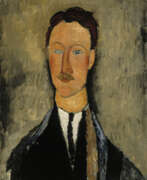Contemporary art Knave of Diamonds


Arthur Vladimirovich Fonvizin (Russian: Артур Владимирович Фонвизин), a Soviet painter renowned for his mastery in watercolor, was born on January 11, 1883, into a forester's family. From a young age, following a transformative experience at a circus, Fonvizin developed a profound love for drawing. His journey into the art world began with his education at the Moscow School of Painting, where he rubbed shoulders with avant-garde artists and later furthered his studies in Munich among a vibrant community of Russian painters. Fonvizin's early work, influenced by symbolism and the lyrical primitive style, included notable pieces such as "The Bride" (1902) and "Leda" (1904).
Throughout his career, Fonvizin was an active participant in significant art movements and exhibitions, such as the Blue Rose, Jack of Diamonds, and the World of Art movement. His transition to watercolors marked a defining moment in his artistic journey, allowing him to capture the ephemeral beauty of landscapes, portraits, and scenes from pre-revolutionary life with a directness and vibrancy that became his hallmark.
Despite facing challenges, including criticism for formalism and being exiled due to his German heritage, Fonvizin's resilience and dedication to art remained unwavering. His works, celebrated for their lack of preparatory sketches and immediate application of paint, are held in high esteem and featured in prestigious collections like the Tretyakov Gallery and the Pushkin Museum. Among his famous works are "The Circus. Horsewoman" (1936) and portraits of ballerinas from the Bolshoi Theater, showcasing his lifelong fascination with the circus and theater.
For collectors and experts in art and antiques, Fonvizin's oeuvre offers a unique glimpse into the soul of early 20th-century Russian art, marked by its lyrical beauty and emotional depth. To stay updated on sales and auction events related to Arthur Vladimirovich Fonvizin's work, signing up for updates is recommended. This subscription ensures access to the latest information on the availability of his mesmerizing watercolor paintings.


Mikhail Fyodorovich Larionov (Russian: Михаил Фёдорович Ларионов) was a distinguished Russian avant-garde artist, painter, and founder of the Rayonism movement, whose contributions significantly influenced early 20th-century modern art. Born in Tiraspol, then part of the Russian Empire, Larionov's pioneering spirit in both painting and stage design left an indelible mark on the realms of culture and art. His dedication to exploring new artistic techniques and expressions made him a central figure among Russian artists, pushing the boundaries of traditional painting and engaging in innovative artistic dialogues.
Larionov's artistry was not confined to a single genre; he was instrumental in the development of Russian avant-garde art, exploring and contributing to various movements such as Neo-Primitivism before founding Rayonism. This movement, which he developed alongside Natalia Goncharova, his lifelong partner and fellow artist, sought to express the dynamic interplay of light and color, breaking away from the conventional forms and perspectives of the time. Larionov's work in this area highlighted his belief in the power of abstract forms and the potential of art to capture the energy and rhythm of modern life.
His contributions are celebrated in major museums and galleries worldwide, with his works being pivotal in understanding the evolution of modern art. Notable works by Larionov are held in prestigious institutions such as the Russian Museum in St. Petersburg, the Tretyakov Gallery in Moscow, and the Museum of Modern Art in New York, underscoring his international recognition and the lasting impact of his artistic innovations.
For collectors and experts in art and antiques, Mikhail Fyodorovich Larionov's legacy offers a rich field of study and appreciation. His works not only embody the innovative spirit of early 20th-century art but also represent a bridge between Russian cultural heritage and the broader currents of European modernism. To stay informed about new product sales and auction events related to Mikhail Fyodorovich Larionov, we invite you to sign up for updates. This subscription is a valuable resource for enthusiasts keen to explore the depth and diversity of Larionov's contributions to modern art.


Léopold Survage was a French painter of Finnish origin. Trained in Moscow, he identified with the Russian avant-garde before moving to Paris, where he shared a studio with Amedeo Modigliani and experimented with abstract movies. He also gained commissions for Serge Diaghilev's Ballets Russes.


Nadezhda Andreevna Udaltsova (Russian: Наде́жда Андре́евна Удальцо́ва) was a Russian avant-garde artist known for her contributions to Cubism and Suprematism and her participation in the avant-garde movement of pre-revolutionary Russia. Udaltsova was born into an officer's family in Orel, western Russia, on December 29, 1886, and died on January 25, 1961, in Moscow, USSR. Udaltsova was deeply influenced by French Cubism, which she encountered in the art collection of Sergei Shchukin. This encounter was a decisive turning point in her artistic path, leading her to post-impressionism and then to avant-garde art forms.
After the 1917 revolution, her art was recognized by the new regime. Udaltsova played a significant role in education, as a professor and senior lecturer at VKhUTEMAS, the Higher Art and Technical Workshops, and a member of the Institute of Artistic Culture (Inhuk). Despite hardships, including the NKVD's execution of her husband Alexander Drevin in 1938, and becoming persona non grata in Soviet art circles, she continued her artistic endeavors, holding a solo exhibition in 1945 and participating in a group exhibition in 1958.
Udaltsova's legacy is remarkable not only for her artistic achievements, but also for the challenges she overcame. Her work is in prestigious collections, including the Museum of Modern Art (MoMA), attesting to her indelible impact on the art world.
For those interested in learning more about Nadezhda Andreevna Udaltsova's work and life, it will be helpful to visit the museums that house her works or subscribe to our newsletters about exhibitions and auctions featuring her art. This will allow a deeper understanding of this remarkable artist's contribution to the avant-garde movement and the art world in general.







